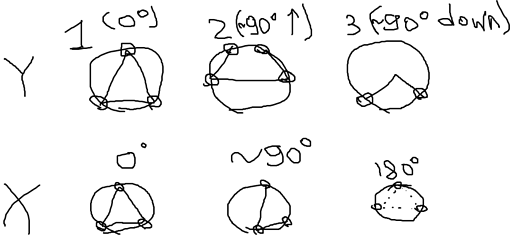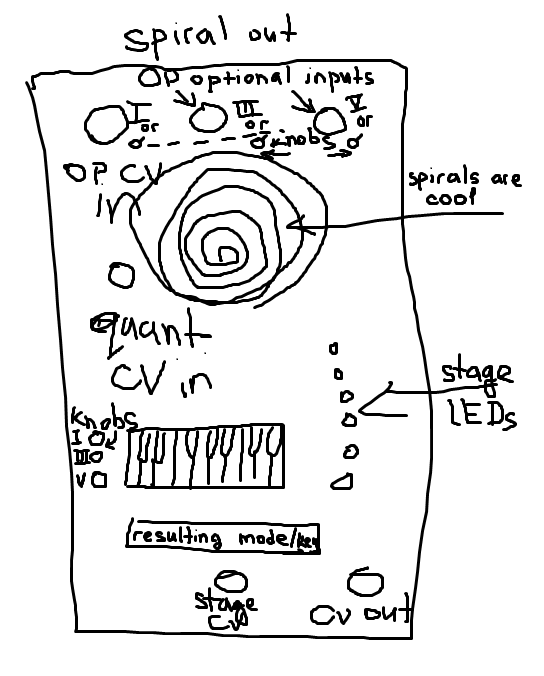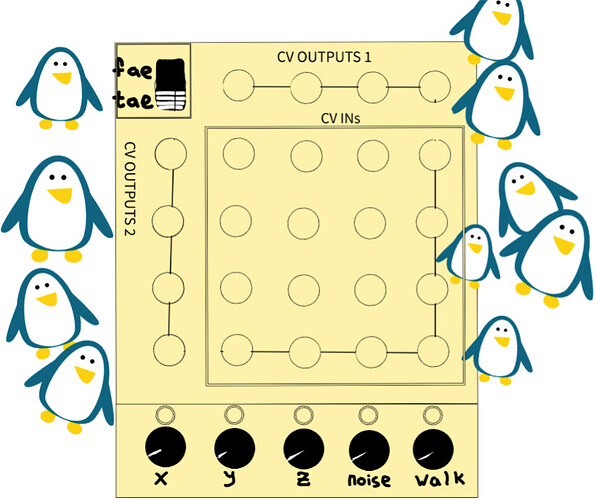Haha, I am not, but that deserves to be in the museum! I love this kind of low effort design… It looks naive, but cute
Needs more Vin Rouge!
It’s a kind of ‘so bad that it’s actually good’ thing.
Can someone make these for him with this exact panel design?
Maybe @computerscare would be the correct choice?
I like that panel a lot. But I would ask for more details about what the knobs and switches look like in other positions. Last time I worked for a large audio company I used the characters from Aqua Teen Hunger force for my compressor faceplates. With added decoration in MS Paint.
I thin this would do what you’re asking for, right? VCV Library - AlliewayAudio Bumper
Or this one ?
This looks like it, but a bit too complicated, i think. A great module though, but that’s like hammering nails with a… module. Hahaha
Almost! Well, it could do the thing. But you have to do math first. Cause you have to set up the number of steps and not the increment itself. Anyway, thanks. I guess that is as good as what I wanted.
you can use TIMEX too
in the lower part there are 2 counters
you can set the FINAL TARGET of the counter in the field TARGET and with a pulse you can increase the COUNT (the counter must be active!)
the output (from the BLUE socket) is always ((10v / TARGET) * COUNT)
in this example I’ve set the target to 100 and the count is at 29 and the BLUE socket is outputting 2.9 volts
Oooh! I see. Somehow it doesn’t surprise me, haha. There are lots of modules that I haven’t explored at all in the NYSTHI collection. I mean, there are over a hundred already… We would need a nysthi.wiki soon, I guess! Thanks for that and for the info about TIMEX!
Just for the record I made a little prototype that is available as Celesta in dist_V2.1.8-beta.zip. Actually I prefer Celei that can be used for similar purposes.
Please note that this plugin is not in the Library and may not be reliable in every situation. So only use it for experimenting and extending your wishlist once a proper developer pops-up.
This proposal was previously reviewed (specially from design point of view) and a few existing module were also suggested. But ACC from docB seems to be an obvious choice for me. @Andre_M?
Oh yeah. Somehow i missed this module. That’s exactly what i had in mind!
Some new random thoughts:
I think CV compressor would be a nice thing to have. It works like any compressor: you set a threshold (maybe two of them, low and high) and anything higher\lower is becoming attenuated according to two separate ratios for higher and lower notes. No attack\release, of course but maybe an ability to sidechain it to something would be nice to have. Also I am curious how it would work with sounds… two separate thresholds could create some interesting asymmetric sounds if you compress the peaks…***usual compressors DO work with CV, but they click like crazy even with attack set on minimum.
I think it would be cool to have a module for videofiles and interactions with them. Maybe generating gates when the screen or particular pixel is black or white, or something other, i don’t know… My concern is that it would be very hard on CPU\GPU, but maybe I am wrong
The last one for today is another variation on Euclidean sequencer. This one is actually 3D or something. So imagine that the circle of Euclidean sequencer is actually an outline of a sphere that you are looking at from above. The obvious thing would be to add X and Y axises to change the cut or something. The outline of a figure should be locked on the outline\contour of a sphere for it to work properly, of course (and maybe it would also be cool to have two options what to do with the parts of a figure that you do not see: compress or hide). So, on the picture below i tried to draw what I see:
I am not sure if somebody made this kind of module already… It looks like an obvious idea. But again, maybe it’s not easy to implement
Two new ideas for any crazy developers
First one is simple: it’s a sequencer with two (or more) “reset” positions. Like, say, it goes 1-2-3-4-5-6 and receives a reset command, normally it would go to the first position, but here you can set the second reset to whatever you like, maybe 5. So it would reset to 5 and continue 5-6-7-8-1-2… I think it should be simple… Unlike the second idea that I have.
Vector field oscillator. Some kind of wavetable-ish thing. So you have a vector field (Perlin noise) that is maybe set like in Topograph for example or randomly generated on reset command. Then you lay your wave on this field, and the line of your wave follows the “landscape” (probably we need to set how strictly it does that). Of course, there are problems, as usual… Like what if we choose a part of this field that consists of a single trench at the center horizontally (a) or vertically (b) or there’s a dot that makes our wave to disobey the laws of time (c). The further research is needed, hahaha
My Meander module is a bit like that. I create a 1D field of fractal Brownian motion 1/f correlated noise. I treat the 1D as time, so this is time correlated noise. That noise is what makes Meander “meander” (with note pitch information correlated over time) in a fractal manner.
Whereas Meander only uses 1D 1/f noise, the library that is included in the Meander open source code supports 1D, 2D, 3D and 4D 1/f noise. I developed this for my game engine that I developed from 1998-2005. Mostly I used the fBm noise for general 2D procedural textures by using 3D 1/f noise with two dimensions of space (width and height) and one of time. This was great for generating clouds. I use quintic interpolation on a lattice.
The fBm 1/f noise has two user settable parameters: number of octaves and a “period” time correlation horizon. The full fBm noise has two additional paramaters: lacunarity and persistence.
Anyway, it would not be trivial, but I can imagine a lot of fun could be had using such textures in VCV Rack.
For my game engine and scientific research 3D work, I implemented my fBm noise library on the GPU under CUDA and DirectCompute for massively parallel computed dynamic textures in real time.
Well, I could go on forever, but no one wants me to do that ![]()
It’s really cool! But a bit esoteric for me. I don’t know much about programming, sadly. But I bet that lots of people actually appreciate your technical explanations! Developers and such… My other stupid idea is to interview people (maybe next year), and it would be cool to interview you about games and music and Meander, to de-mystify this module a bit.Cause it looks very menacing tbh, haha. I still don’t know how to use it. Even the manual looks scary! SO it would be nice to make it closer to people
I have an idea that, again, might be stupid. So it’s the quantizer that pics the mode\key based on the input. I imagine it should work like this: it receives an input and decides what it is. Maybe you can hard set the tonic, so let’s go with this idea. We set E as a tonic, then we get something close to G#, it quatizes it, so our module sieves the possibilities and throws out everything that doesn’t have the major third. Then we get something close to D. So it sieves everything again. And at the end we have E mixolydian or something. I guess the best way to use it would be with two different “circuits”, one receives the “operating voltage” and the other one is actually quantizing everything. We can reset the module so it would start again and maybe arrive into different mode. I like to imagine it being a spiral that blossoms out or something like that. Musically it would be interesting too, cause it would go through different stages of quantization live. So it would output just E then E and G# and then E G# and D and then more and more… Would be cool to have a stage voltage output too. Like on 1st stage with E it outputs 1 volt then goes to 2 and then 3 and so on. We can attenuate and slew it and have a ramp maybe. Want me to draw it? Oh! So you like my drawings! Thanks…
I guess there is something similar in the VCV library, but not quite the same, I think
New idea! This time I decided to use the online sketch tool, so it would be easier to understand what you see, maybe. Alright, so I was thinking about the Grids\Topograph and how maps could be applied to music. And I was also thinking about CV Matrixes and how they DO NOT look like what I want them to look, cause I had this image in my head. It’s like the matrix is all CV ins and CV outs, no jumpers, just pure wires and madness. So I combined this two ideas et voila! This anisotropic penguin was born! Penguins are cute.
The basic idea
Alright, so it is a CV matrix with 8 (on the picture, you can do 4 or 6 or 20 or I don’t know… 1000) CV outs and 16 CV ins (same story, you can change the number if you feel like making this module). All the inputs are attenuated behind the scene by a map. So if any CV In happens to hover over the +10 “mountain peak”, it is not attenuated, if it’s over a hill of +5, it’s attenuated by 50% and if there’s a “sea level”, it kills the signal. The same applies to the negative voltage. Then the inputs get summed up and sent to the output accordingly to the row\column.
Anisotropy
So if you connect EG to CV in 1,1 (1 row, 1 column) and LFO both to CV in 1,2, and CV in 2,1 the outputs CV out 1 horizontal (CV OUT 1 line) and CV out 1 vertical (CV OUT 2 column) would be different. Well, given that the map is non-repeating and well shuffled, haha.
Fae an tae
The described behaviour applies to the Tae “mode”. Tae means “To” in scottish and I thought it would be funny to make this Module a bit scottish. Scottish penguins! Funny as hell. So “Tae” is a mode that attenuates the signals that are coming to the matrix according to the map. Now Fae is the same, but in reverse. Fae means “From”, so it takes the values of the map and attenuates it according to the CV In signals. If there’s nothing in the input, I think the value should be attenuated to 0 (ot not. If you set the first row\column to send the unattenuated signals with no wires connected, it would make an interesting sequencer… So you decide!). Maybe you would like to experiment and apply some kind of second layer of the map to attenuate another map. This would be mad, I like it.
X-Y-Z-Noise-Walk
So I think it is obvious what X and Y knobs are doing to anyone who had an experience with Grids\Topograph, It moves the map. Z attenuates the Map. It’s like master attenuation. At 0 it’s flat, just a plateau with nothing happening and at 100 the highest parts are at 10v and the lowest parts are -10v. Noise introduces some sudden variations with no smoothening at all. Walk moves the map randomly and the knob sets the speed. Well, that’s all for today’s crazy ideas. Would be really cool if someone were to make this thing. I need it right now. Bonus points for penguins and\or cats.
I’m kind of confused by thie visual representation.
Would you please consider issuing the same image in your classic black-and-white drawing style? ![]() I like that one much better.
I like that one much better.
Hahaha, I started doing it in Paint, but couldn’t align the inputs\ouputs for some reason. And it looked like i am taking the pish out of OCD people and\or just normal human beings that are used to our three-dimensional space. It was too scary to post, the horror was real, the whole thing was non-euclidean and alien to the human mind. Next time I will do the classic design though, I promise!




